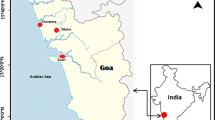Abstract
The fresh water bivalves, Lamellidens corrianus, Lamellidens marginalis, and Indonaia caeruleus were exposed to chronic concentration of arsenic (0.1719 ppm), cadmium (0.1284 ppm), copper (0.033 ppm), lead (1.50 ppm), mercury (0.0443 ppm) and zinc (1.858 ppm) separately up to 30 days in laboratory. Dry weight of each animal was used to calculate metal concentrations (μg/g) and the metal body burden (μg/individual). It was observed that lead (1235.4 μg/g) and arsenic (37.9 μg/g) concentration were highest in Lamellidens corrianus, zinc (3,032.3 μg/g) was highest in Lamellidens marginalis, while mercury (5.87 μg/g), cadmium (142 μg/g) and copper (826.7 μg/g) was highest in Indonaia caeruleus.
Similar content being viewed by others
References
Abdullah MH (2008) Metals (Cd, Cu, Cr, Pb and Zn) in Meretrix meretrix roding, water and sediments from estuaries in Sabah, North Borneo. Int J Environ Sci Educ 2:69–74
Abdullah MH, Jovita S, Ahmad ZA (2007) Heavy Metals (Cd, Cu, Cr, Pb and Zn) in Meretrix meretrix roding, water and sediments from estuaries in Sabah. N Borneo Int J Environ Sci Educ 2(3):69–74
APHA (1998) Standard methods for the examination of water and wastewater, 20th edn. American Public Health Association, Washington DC
Barbour MT, Gerritsen J, Snyder BD, Stribling JB (1997) Revision to rapid bioassessment protocols for use in streams and rivers: periphyton, benthic macroinvertebrates, and fish. EPA 841-D-97–002. US Environmental Protection Agency, Washington DC
Birge WJ, Price DJ, Kercher MD (1998) Metal body burden in stoneroller minnows (Campostoma anomalum) from the Bayou Creek System. Submitted to Jon Maybriar, FFOU
Boyden CR (1974) Trace element content and body size in molluscs. Nat Lond 251:311–314
Casas S, Gonzalez JL, Andral B, Cossa D (2008) Relation between metal concentration in water and metal content in marine mussels (Mytilus galloprovincialis): impact of physiology. Environ Toxicol Chem 27:1543–1552
Christopher B, Ndome UB, Ekaluo FE, Asuquo AE (2010) Comparative bioaccmulation of heavy metals (Fe, Mn, Zn, Cu, Cd and Cr) by some edible aquatic molluscs from the Atlantic coastline of South Eastern Nigeria. World J Fish Marine Sci 2(4):317–321
Davies IM, Pirie JM (1980) Evaluation of a ‘mussel watch’ project for heavy metals in Scottish coastal waters. Mar Biol 57:87–93
Finney DJ (1971) Probit analysis. Cambridge University Press, London
Forbes VE, Forbes TL (1994) Ecotoxicology in theory and practice. Chapman and Hall, London, pp 68–71
Garcia-Rico L, Ruiz RER, Jimenez JV (2001) Determination of total metals in cultived oysters (Crassostrea gigas) from the northwest coast of Mexico by microwave digestion and atomic absorption spectrometry. J AOAC Int 84:1909–1913
Huang H, Wu JY, Wu JH (2007) Metal monitoring using bivalve shellfish from Zhejiang Coastal water, East China Sea. Environ Monit Assess 129:315–320
Hung TC, Meng PJ, Han BC, Chuang A, Huang CC (2001) Trace metals in different species of mollusca, water and sediment form Taiwan coastal area. Chemosphere 44:833–841
Ibrahim N, Mat I (1995) Trace element content in relation to the body weight of the marine bivalve, Anadara Granosa with special reference to the application of Inaa and Icp-AES as analytical techniques
Issam EG, Menge S, Miersch J, Abdelghani G, Ali B, Khalid E, Krauss GJ (2003) Quantification of metallothionien-like protein in the mussel Mytilus galloprovincialis using RP-HPLC fluorescence detection. Environ Sci Technol 37:5739–5744
Lee J-S, Lee B-G (2005) Effects of salinity, temperature and food type on the uptake and elimination rates of Cd, Cr, and Zn in the Asiatic Clam Corbicula fluminea. Ocean Sci J 40(2):79–89
Naimo TJ (1995) A review of the effects of the heavy metals on freshwater mussels. Ecotoxicol 4:341–362
Paez-Osuna F, Ochoa-Izaguirre MJ, Bojorquez-Leyva H, Michel-Reynoso IL (2000) Macroalgae as biomonitors of metal availability in coastal lagoons from the subtropical Pacific of Mexico. Bull Envrion Contamin Toxicol 64 (in press)
Phillips DJH (1990) Furness RW and rainbow. In: Walsh PM (ed) Metals in the marine environment. CRC Press, Florida, pp 81–99
Rutzke MA, Gutenmann WH, Lisk DJ, Mills EL (2000) Toxic and nutrient element concentrations in soft tissues of zebra and quagga mussels from Lakes Erie and Ontario. Chemosphere 40:1353–1356
Shulkin VM, Presley BJ (2003) Metal concentration in mussel Crenomytillus grayanus and oyster Crassostrea gigas in relation to contamination of ambient sediments. Environ Int 29(4):493–502
Teodorovic I, Djukic N, Maletin S, Jugovac N, Miljanovic B (2000) Metal pollution index: proposal for freshwater monitoring based on trace metal accumulation in fish. Tiscia 32:55–60
Ullven J (1993) Bivalve compatibility with chlorophenols murtovedessa study. Water Environ Gov Publ Ser A (137):51s
Wang WX, Yan QL, Fan W, Xu Y (2002) Bioavailability of sedimentary metals from a contaminated bay. Marine Ecol Programme Ser 240:23–38
Waykar B, Shinde SM (2011) Assessment of the metal bioaccumulation in three species of freshwater bivalves. Bull Environ Contam Toxicol 87(3):267–271
Widdows J, Donkin P, Salked PN, Cleary JJ, Lowe DM, Evans SV, Thomson PE (1984) Relative importance of environmental factors in determining physiological differences between two populations of mussels (Mytilus edulis). Mar Ecol Prog Ser 17:33–47
Acknowledgments
Financial assistance from University Grants Commission is appreciatively acknowledged.
Author information
Authors and Affiliations
Corresponding author
Rights and permissions
About this article
Cite this article
Waykar, B., Deshmukh, G. Evaluation of Bivalves as Bioindicators of Metal Pollution in Freshwater. Bull Environ Contam Toxicol 88, 48–53 (2012). https://doi.org/10.1007/s00128-011-0447-0
Received:
Accepted:
Published:
Issue Date:
DOI: https://doi.org/10.1007/s00128-011-0447-0




